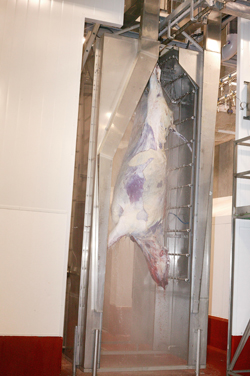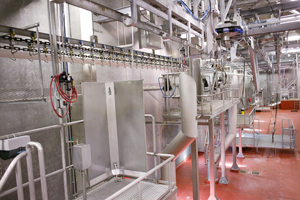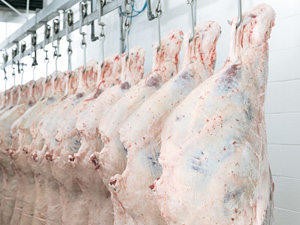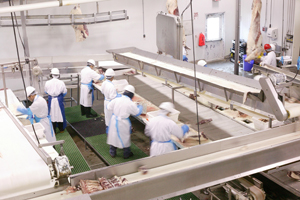There are no bacteria in the muscles of healthy cattle, but when meat surfaces are exposed during dressing operations, they can be contaminated with bacteria from the hide, gastrointestinal tract, or slaughter plant environment. Minimizing the transfer of bacteria to the carcass, and treating the carcass or meat to reduce or eliminate the bacteria that are transferred ensures the microbiological safety of beef.
Introduction
In the late 1990’s, Canada’s federally inspected packing plants implemented hazard analysis critical control point (HACCP) systems to reduce the occurrence and levels of pathogenic microorganisms on meat.
Because packing plants are privately owned, their food safety treatments may vary slightly but are all regulated by the CFIA and continually monitored to ensure food safety.
Concerns about microbiological hazards and risks, particularly from Escherichia coli O157:H7, have led to requirements for testing of carcasses for E. coli and trimmings for E. coli O157:H7. Food safety interventions have been implemented as parts of the HACCP systems at beef processing plants in the United States and Canada to address those concerns and comply with the mandated microbiological standards.
In laboratory settings, all of the food safety interventions that are currently employed are effective for inactivating bacteria or removing them from meat surfaces. However, laboratory results may not equate to commercial practice because of differences in the surfaces on which the bacteria are deposited, the numbers of bacteria on surfaces, the ways that the treatments are applied, the physiological conditions of the bacteria, etc. Therefore, this discussion will focus on food safety interventions currently applied at beef packing plants and their microbiological effects in commercial practice.
Washing or Dehairing of Hides
Studies have shown that washing live animals with water before slaughter to remove visible contamination does not result in any significant improvement of the microbiological conditions of dressed carcasses. In fact, dressing carcasses with wet hides can result in increased carcass contamination. This practice is not currently employed in Canadian packing plants.
Aerobes: organisms that survive and grow in environments with oxygen
Enterobacteriaceae: a large family of bacteria that includes Salmonella and E. coli
On-line hide wash cabinets that wash beef carcasses before they are skinned have been installed in some large beef packing plants. After the cattle have died, the hides are scrubbed with a solution of 1.5% sodium hydroxide (lye) at 55°C and are rinsed with a NaOCl (bleach) solution containing 1 ppm free chlorine before the animal is skinned. A vacuum is used to remove excessive liquid from where opening cuts will be made on the hide. This treatment can reduce the numbers of E. coli and total aerobes on skinned carcasses by 90% and 99%, respectively, compared to carcasses that were not washed before skinning. In another study, the treatment reduced the numbers of aerobes and Enterobacteriaceae on the hides by 99% and 99.9%, respectively. The prevalence of E. coli O157:H7 was 2% on carcasses that were washed before skinning, and 17% on carcasses that were not washed before skinning.
Hide-on carcasses can also be dehaired with two applications of 10% sodium sulfide (Na2S) and neutralizing residual Na2S with two applications of 3% hydrogen peroxide (H2O2), with the carcasses being washed with water after each solution is applied. Two studies showed that the treatment was ineffective for reducing numbers of aerobes and Enterobacteriaceae on hides. However, in one study the numbers of those bacteria were 99% less, and the prevalence of E. coli O157:H7 was much less on skinned carcasses when hide-on carcasses were dehaired than when hide-on carcasses were not treated.
Spraying Carcasses with Antimicrobial Solutions

The effects of spraying beef with lactic acid (found in yogurt), acetic acid (found in vinegar) and peroxyacetic acid (weaker than acetic acid) have been extensively studied. These solutions have been routinely applied to carcasses at substantial numbers of North American beef packing plants. Applying a 2% lactic acid solution to beef carcasses may reduce numbers of aerobes and E. coli by 90%, but it is not always effective.
The lack of effect of some treatments could be caused by a variety of factors, such as:
- when an acid spray is applied immediately after a carcass wash, the water remaining on the meat surface may dilute the acid to ineffective concentrations;
- when the acid applied does not uniformly cover the carcass’ entire surface, bacteria on dry or inadequately wetted surfaces will not be affected;
- some bacteria survive food safety interventions because they are protected (e.g. by folds or cracks in fat surfaces). If this is the case, bacteria that survive one treatment (e.g. pasteurization) may also survive a secondary treatment (e.g. acid spray).
One study conducted at a large Canadian beef packing plant found that spraying carcasses with 5% lactic acid after skinning (but before evisceration), and again after carcass splitting (but before pasteurization) reduced the numbers of coliforms and E. coli substantially. The effectiveness of acid treatments, like any other chemical interventions, depends on contact of the bacteria with the acid solution. No acid solution will kill bacteria on surfaces or in cracks that the acid does not reach, so no treatment can be expected to eliminate all bacteria from meat.
Washing Skinned Carcasses
Beef packing plants usually wash carcasses after skinning but before evisceration, and wash carcass sides at the end of the carcass-dressing process. If carcasses are heavily contaminated during skinning or subsequent operations, washing for relatively long times will substantially reduce the numbers of bacteria on carcasses. If they are not washed long enough, the washing step may redistribute the bacteria, but have no or little effect on the microbiological conditions of the meat.
Removal of Visible Contamination
Visible contamination, such as mud or dirt, is removed from carcasses by cutting away the contaminated tissues and/or by vacuum cleaning with hot water or steam. All such treatments are effective for removal of visible contamination and bacteria that are associated with it. However, there is no relationship between visible contamination and microbiological contamination; i.e., surfaces carrying no visible contamination can harbor large numbers of bacteria, while surfaces having visible contamination may carry few bacteria. Thus, trimming and vacuum cleaning to remove visible contamination do not in general improve the microbiological conditions of carcasses when applied only to sites showing visible contamination.
Pasteurization

Most large North American beef packing plants routinely pasteurize beef carcass sides with hot water or steam at the end of the carcass-dressing process. The heat of pasteurization rapidly inactivates bacteria. Scientific studies have evaluated steam pasteurizing treatments at temperatures ranging from 75 to 105°C, with treatment times ranging from 6 to 11 seconds. Maximum reduction of pathogens can be achieved at temperatures of 85°C or higher for 11 seconds. Similar optimum conditions have been determined for hot water pasteurization, using an apparatus that delivers sheets of water to carcasses.
When appropriately applied, pasteurization with steam or hot water can reliably reduce the numbers of aerobes by 99% and E. coli by 99.9%. Because pasteurization uniformly heats the entire carcass surface (including parts that may not be reached by other treatments), pasteurization is generally more effective than many other interventions.
Carcass Chilling

Carcass sides are chilled to temperatures below 7°C to slow bacterial growth. Most large packing plants have adopted spray chilling, which involves spraying carcasses with water or acid solutions. This speeds chilling rates with no loss of carcass weight. Increases, decreases or no changes in numbers of bacteria on carcasses as a result of spray chilling have been reported.
Small abattoirs often use dry chilling, which exposes carcasses to a flow of refrigerated air. This also dries the carcass surface, which helps ensure the microbiological safety and storage stability of beef. Various studies have reported reductions in bacterial counts during dry chilling processes. Although bacteria differ substantially in their susceptibilities to the effects of drying, Gram-negative bacteria (like E. coli) are generally more sensitive to drying than Gram-positive bacteria (e.g. most aerobes). Thus, greater reductions in numbers of coliforms and E. coli than in the numbers of total aerobes can be expected.
Recent studies conducted at a small federally inspected plant in Canada and at seven small state-inspected packing plants in the U.S. showed that dry chilling reduced E. coli numbers by 99%.
Microbiological Conditions of Carcass Sides, Cuts, and Trimmings

In recent years, the microbiological conditions of beef carcass sides have been greatly improved by improved carcass-dressing practices and implementation of new food safety interventions to reduce pathogens. One recent study conducted at a large packing plant in Canada found that carcass sides entering the breaking facilities carry fewer than two (2) viable E. coli cells per side, showing that carcasses carrying extremely low numbers of E. coli can be and are produced in commercial practice. However, the meat can be contaminated during fabrication, resulting in higher numbers of E. coli on cuts (1 viable cell per 100 cm2) and trimmings 1 viable cell per 1000 cm2).
Spraying meat and conveyors with a solution of 200 ppm peroxyacetic acid is routinely applied during carcass fabrication at some large packing plants. There were no differences between the numbers of E. coli recovered from conveyors and products that were and were not sprayed with peroxyacetic acid, showing that this intervention is ineffective. As above, this is probably due to bacteria hiding in cracks or folds in the meat.
Appropriate and effective procedures for preventing contamination of beef during carcass breaking processes must be identified and implemented if the microbiological conditions of beef products are to be further improved. Ensuring that knives, gloves and equipment are frequently and properly washed is particularly important.
Feedback
Feedback and questions on the content of this page are welcome. Please e-mail us at info@beefresearch.ca.
Acknowledgements
Thanks to Dr. Xianqin Yang, Agriculture and Agri-Food Canada Research Scientist, for contributing her time and expertise to writing this page.
Expert Review
This content was last reviewed March 2016.
This topic was last revised on June 23, 2023 at 2:10 pm.